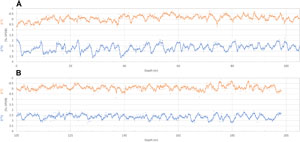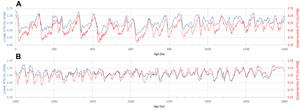Clemens, S.C., Kuhnt, W., LeVay, L.J., and the Expedition 353 Scientists
Proceedings of the International Ocean Discovery Program Volume 353
publications.iodp.org
Data report: Site U1448 Pleistocene benthic foraminiferal stable isotopes, Andaman Sea, IODP Expedition 3531
S.C. Clemens2
1 Clemens, S.C., 2022. Data report: Site U1448 Pleistocene benthic foraminiferal stable isotopes, Andaman Sea, IODP Expedition 353. In Clemens, S.C., Kuhnt, W., LeVay, L.J., and the Expedition 353 Scientists, Indian Monsoon Rainfall. Proceedings of the International Ocean Discovery Program, 353: College Station, TX (International Ocean Discovery Program). https://doi.org/10.14379/iodp.proc.353.203.2022
2 Department of Earth, Environmental, and Planetary Sciences, Brown University, USA. steven_clemens@brown.edu
Abstract
This data report presents the benthic foraminiferal oxygen and carbon isotope records for International Ocean Discovery Program Site U1448 in the Andaman Sea. The record includes 1764 analyses spanning from the core top to 203.19 m core composite depth below the seafloor, Method D. This depth interval spans the past 2.755 My with an average temporal resolution of ~1.9 ky (14 cm sample interval).
1. Introduction
Site U1448 is located atop a rise at 1091 meters below sea level (mbsl) ~44 km offshore Little Andaman Island ( Clemens et al., 2016). The interval cored reached 420.6 m core depth below seafloor, Method A (CSF-A), recovering Miocene to recent sediments for use in reconstructing changes in regional monsoon circulation and ocean circulation at tectonic to suborbital timescales. The stable isotope data presented here spans the very latest Pliocene through Holocene, providing the chronostratigraphic control, sea level, and carbon isotopic information required to meet expedition objectives.
2. Methods and materials
2.1. Stable benthic foraminiferal isotopes
Site U1448 was sampled at 14 cm resolution from 0 to 203.19 m core composite depth below seafloor, Method D (CCSF-D). The CCSF-D depth scale designation denotes that samples were taken along a splice composed of Holes U1448A–U1448C designed to account for (avoid) missing sediment sections between cored intervals at each individual hole.
Samples were freeze-dried, wet sieved at 63 µm, and dried in an oven at 50°C. The >63 µm fraction was sieved into four size fractions: 63–150, 150–250, 250–355, and >355 µm. Uvigerina spp. was primarily utilized due to abundance, and Cibicidoides wuellerstorfi, Cibicidoides mundulus, and Bolivinita quadrilatera were utilized as necessary when Uvigerina was absent or low in abundance. Anywhere from 1 to 12 specimens were picked, predominantly from the 250–355 µm fraction, and the >150 and >250 µm fractions were utilized as necessary.
Samples were analyzed using a MAT252 isotope ratio mass spectrometer coupled to a Kiel III carbonate device, reacted by individual acid addition (99% H3PO4 at 70°C). A total of 1764 samples were analyzed, including replicates (Table T1).
A total of 230 in-house standards were analyzed in the course of the sample analyses. Multiple analyses of BYM (n = 90) yield −2.25 ± 0.02 (1σ) for δ13C and −6.44 ± 0.07 (1σ) for δ18O. Multiple analyses of Carrara marble (n = 141) yield 2.05 ± 0.02 (1σ) for δ13C and −1.87 ± 0.05 (1σ) for δ 18O.
Isotopic offsets (Tables T1, T2) between C. wuellerstorfi and Uvigerina spp. are accounted for by subtracting 0.51 (±0.17; 1σ; n = 134) from Uvigerina spp. values for δ18O and adding 0.93 (±0.24; 1σ; n = 134) to Uvigerina spp. values for δ13C. Isotopic offsets between C. wuellerstorfi and B. quadrilatera are accounted for by subtracting 0.53 (±0.12; 1σ; n = 12) from B. quadrilatera values for δ18O and adding 1.01 (±0.19; 1σ; n = 12) to B. quadrilatera values for δ13C. No offsets are applied to C. mundulus. All results are calibrated to National Institute of Standards and Technology carbonate isotope standard NBS19 and are reported as parts per thousand Vienna Peedee belemnite (‰VPDB).
2.2. Chronology
Biostratigraphic analyses ( Clemens et al., 2016) provided the initial age control, followed by correlating structure in the benthic δ18O record to the LR04 (Lisiecki and Raymo, 2005) global benthic stack using AnalySeries software (Paillard et al., 1996). The resulting 100 age control tie points include the base of the Toba ash (74.5 ka in Section 353-U1448A-2H-3, 45 cm [6.04 m CCSF-D]) (Table T3).
3. Results
The benthic carbon and oxygen isotopic records are plotted as a function of depth (Figure F1) and age (Figure F2), displaying clear orbital-scale structure. The average temporal resolution is 1.9 ± 0.64 ky (1σ).
Cross-spectral analysis (Paillard et al., 1996) confirms the high correlation between the global benthic stack and Site U1448 benthic δ18O. The coherence and phase results are as follows: at the eccentricity (100 ka), band coherence is 0.97 and phase is 0.56 ± 1.46 ky; at the obliquity (41 ka), band coherence is 0.98 and phase is 0.52 ± 0.48 ky; at the precession (23 ka), band coherence is 0.89 and phase is 0.2 ± 0.67 ky; and at the precession (19 ka), band coherence is 0.89 and phase is −0.69 ± 0.56 ky. All phase results are less than our average 1.9 ky sample interval.
Structural match to the global benthic stack is excellent with the exception of structure at 2070–2104 ka (146.1–148.8 m CCSF-D). This occurs at a splice tie point (Section 353-U1448B-15H-6, 88.2 cm, tied to Section 353-U1448A-16H-1, 109.7 cm) in the postcruise revision of the splice dated 2 February 2016 that is based on X-ray fluorescence scanning data. The splice table can be accessed at https://web.iodp.tamu.edu/filesR/FileGet-LORE?recordid=2108752. Re-examination of the splice on the basis of this anomalous structure did not reveal an obvious error, but additional examination is warranted.
4. Acknowledgments
The International Ocean Discovery Program (IODP) provided samples for this work under sample request 017275-IODP. The analyses were funded by the US National Science Foundation. Many thanks to undergraduate laboratory assistants for exceptionally diligent efforts in the laboratory, including Grace Berg, August Alto, Burke O’Brien, Lauren Lubeck, Catherine Miranda, Sam Hill-Cristol, Michael Muir, Maura Curry, Katherine Zeven, Isabella Lovelace, Veronica Gordon, Samantha Valentine, and Maya Glicksman. Thanks to Ann Holbourn and Daniel Gebregiorgis for helpful edits, comments, and suggestions.
References
Clemens, S.C., Kuhnt, W., LeVay, L.J., Anand, P., Ando, T., Bartol, M., Bolton, C.T., Ding, X., Gariboldi, K., Giosan, L., Hathorne, E.C., Huang, Y., Jaiswal, P., Kim, S., Kirkpatrick, J.B., Littler, K., Marino, G., Martinez, P., Naik, D., Peketi, A., Phillips, S.C., Robinson, M.M., Romero, O.E., Sagar, N., Taladay, K.B., Taylor, S.N., Thirumalai, K., Uramoto, G., Usui, Y., Wang, J., Yamamoto, M., and Zhou, L., 2016. Site U1448. In Clemens, S.C., Kuhnt, W., LeVay, L.J., and the Expedition 353 Scientists, Indian Monsoon Rainfall. Proceedings of the International Ocean Discovery Program, 353: College Station, TX (International Ocean Discovery Program). https://doi.org/
Lisiecki, L.E., and Raymo, M.E., 2005. A Pliocene-Pleistocene stack of 57 globally distributed benthic δ
18O records. Paleoceanography, 20(1):PA1003. https://doi.org/
Paillard, D., Labeyrie, L., and Yiou, P., 1996. Macintosh Program performs time-series analysis. Eos, Transactions of the American Geophysical Union, 77(39):379. https://doi.org/

